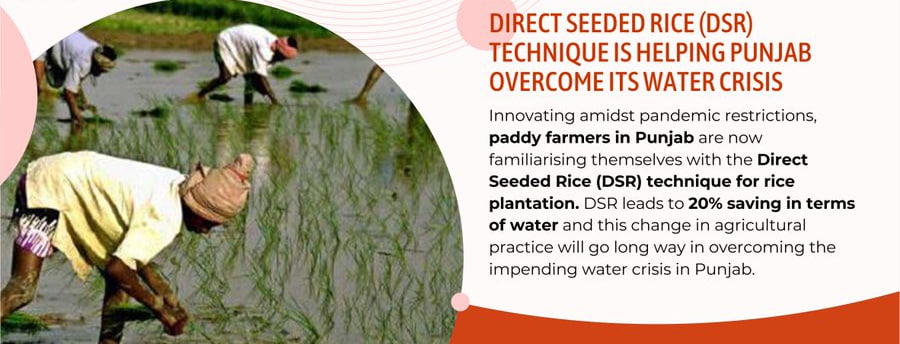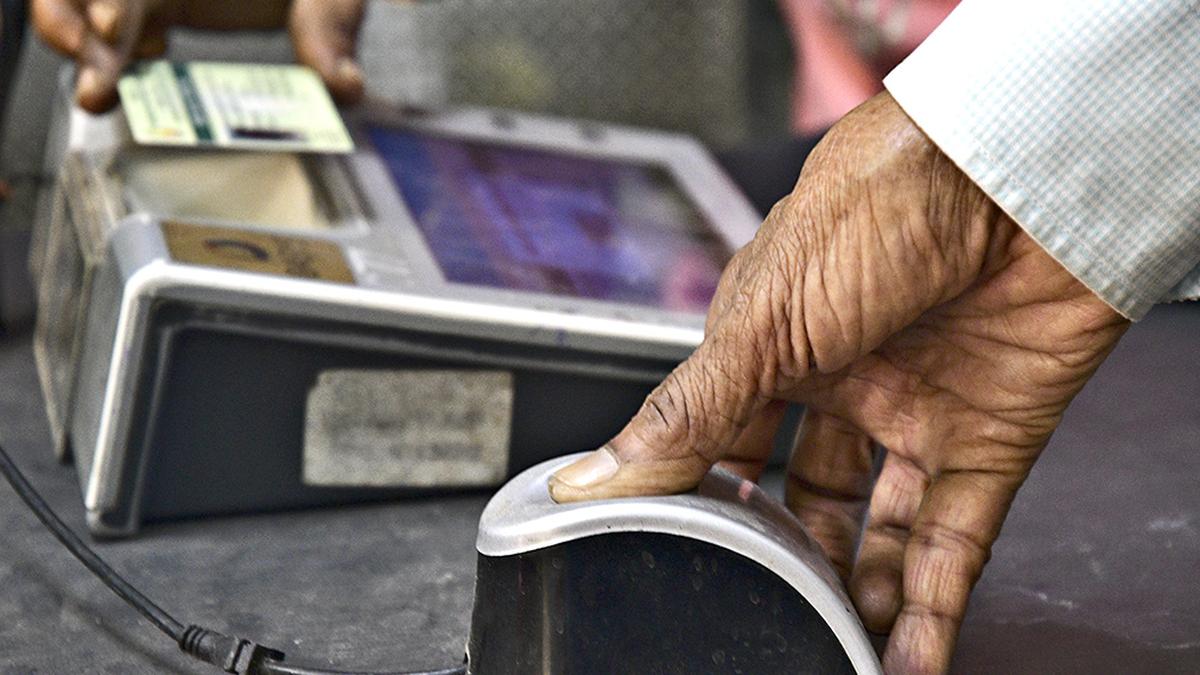
Copyright infringement not intended
Context: Punjab, one of the leading states in paddy production in India, has set an ambitious target of bringing 5 lakh acres under the direct seeded rice (DSR) method this kharif season.
Details
- The Punjab state government has launched a massive campaign to promote the DSR method among farmers and provide them with technical and financial support.
- The state government has identified suitable varieties for different agro-climatic zones of the state and has made arrangements for their availability to farmers.
- The government has provided subsidies on seed drills, herbicides and weedicides to encourage farmers to adopt the DSR method. They set up demonstration plots, farmer field schools and training camps to disseminate the knowledge and skills of the DSR method among farmers.
- The government has roped in experts from Punjab Agricultural University (PAU), Krishi Vigyan Kendras (KVKs) and Agriculture Department to provide technical guidance and monitoring to farmers.
- The government hopes that by adopting the DSR method, farmers will be able to save water, reduce costs, increase income and contribute to environmental sustainability.
Different Types of Paddy Cultivation Methods
- Paddy cultivation is a major agricultural activity in many parts of Asia, especially India, where rice is a staple food for millions of people. Paddy cultivation involves growing rice plants in flooded fields or paddies, where the water level is maintained throughout the crop cycle.
- Paddy cultivation requires a lot of water, labour and inputs, but it also provides many benefits such as high yield, weed control, soil fertility and pest management.
Different methods of paddy cultivation vary depending on the climate, soil, water availability and labour availability. Some of the common methods are:
Broadcasting method
- This is the simplest and oldest method of paddy cultivation, where seeds are sown by hand over the prepared fields. This method is suitable for dry and less fertile areas, where labour is scarce and irrigation is limited.
- The advantages of this method are low cost, easy operation and less seed requirement.
- The disadvantages are low yield, poor quality, high weed infestation and difficulty in harvesting.
Drilling method
- This is a modified version of the broadcasting method, where seeds are sown in rows using a drill machine or a plough. This method is also suitable for dry and less fertile areas, where irrigation is limited.
- The advantages of this method are better seed distribution, higher germination rate, and easier weeding and harvesting.
- The disadvantages are higher cost, more labour requirements and more seed requirements.
Transplantation method
- This is the most popular and widely used method of paddy cultivation, where seedlings are raised in a nursery and then transplanted into the fields. This method is suitable for fertile and well-irrigated areas, where labour is abundant and rainfall is high.
- The advantages of this method are high yield, high quality, better weed control and pest management.
- The disadvantages are high cost, high labour requirement and high water requirement.
Each method of paddy cultivation has its own advantages and disadvantages, and farmers should choose the best one according to their local conditions and preferences. Paddy cultivation is a complex and challenging process that requires careful planning, management and monitoring to ensure a successful harvest.
.jpeg)
Direct Seeded Rice (DSR): A Sustainable and Profitable Method of Rice Production
About
- Rice is one of the most important staple crops in the world, especially in Asia, where it provides food and income for millions of farmers and consumers. However, rice production faces many challenges, such as water scarcity, labour shortage, climate change, and environmental degradation. To overcome these challenges and meet the growing demand for rice, new and innovative methods of rice cultivation are needed.
- One of the potential solutions is direct-seeded rice (DSR), also known as the 'broadcasting seed technique'. DSR is a water-saving method of sowing paddy, where seeds are directly drilled into the fields, without nursery preparation or transplantation.
This method has many advantages over the conventional method, such as:
- Faster planting and maturing of crops.
- Savings on irrigation water by 12-35% under efficient water management practices.
- Reduction of labour and drudgery by eliminating seedling uprooting and transplanting.
- Lower cost of cultivation and higher income.
- Lower greenhouse gas emissions and less soil disturbance.
- Mechanization of DSR creates employment opportunities for youth and women farmers.
However, DSR also faces some challenges that limit its wide-scale adoption, such as:
- Higher seed rates and risk of poor or non-uniform crop establishment.
- Seeds exposed to birds and pests.
- Weed management and higher risk of lodging.
- Lack of suitable varieties and machinery for different agro-climatic conditions.
- Lack of awareness and knowledge among farmers and extension workers.
To address these challenges and make DSR more sustainable and profitable, an integrated and scientific approach is needed. Some of the key steps are:
- Selecting suitable varieties that are tolerant to drought, submergence, salinity, pests, and diseases.
- Using quality seeds that are pre-treated with fungicides and insecticides.
- Adopting proper land preparation techniques that ensure a smooth, level, and weed-free seedbed.
- Applying pre-emergence herbicides within 1-3 days after sowing to control weeds effectively.
- Using appropriate machinery for sowing, weeding, fertilizing, and harvesting.
- Practising efficient water management practices that optimize irrigation scheduling and avoid waterlogging or drought stress.
- Monitoring crop growth and pest incidence regularly and taking timely corrective measures.
- Following recommended agronomic practices such as seed rate, spacing, fertilizer dose, etc.
- Participating in farmer groups or cooperatives that facilitate access to inputs, services, information, and markets.

Best Practices for DSR Cultivation
Land preparation
- A smooth, level seedbed is necessary to ensure that seeds are not planted at depths greater than 10-15 mm. The soil should be moist but not wet at the time of sowing. A stale seedbed technique can be used to reduce weeds and weedy rice by allowing them to emerge before they are killed by herbicides or tillage.
Seed selection
- Use high-quality seeds with a high germination rate, vigour, purity, and resistance to pests and diseases. The seed rate depends on the method of sowing but generally ranges from 60 to 100 kg per hectare. Treat the seeds with fungicides or insecticides to protect them from soil-borne pathogens or insects.
Sowing method
- There are different methods of sowing DSR, such as broadcasting, drilling, dibbling, or using precision equipment. The choice of method depends on the availability of resources, labour, machinery, and water. Broadcasting is the simplest and cheapest method, but it requires more seeds and has less uniformity.
- Drilling is more precise and efficient, but it requires more machinery and skill. Dribbling or hill planting is suitable for sloping lands or where ploughing is difficult. Precision equipment can sow seeds and apply fertilizers simultaneously.
Water management
- DSR can be done in both dry and wet conditions. Dry DSR is usually practised for rainfed and deepwater ecosystems, where seeds are sown onto the dry soil surfaces and then incorporated by ploughing or harrowing.
- Wet DSR is usually practised for irrigated ecosystems, where seeds are sown onto moist soil surfaces or into standing water. The advantage of wet DSR is that it reduces weed pressure and improves crop establishment. However, it requires more water and may cause anaerobic soil conditions.
Weed management
- Weeds are one of the major constraints in DSR cultivation, as they compete with rice plants for nutrients, water, light, and space. Weeds can be controlled by using a combination of cultural, mechanical, biological, and chemical methods.
- Cultural methods include using stale seedbed techniques, crop rotation, intercropping, mulching, etc.
- Mechanical methods include using hand weeding or machine weeding tools.
- Biological methods include using bioherbicides or weed-eating organisms.
- Chemical methods include using pre-emergence or post-emergence herbicides.
Fertilizer management
- DSR requires less fertilizer than other methods due to less nutrient loss from leaching or volatilization. However, fertilizer management is still important to ensure optimal crop growth and yield. The amount and type of fertilizer depend on the soil fertility, crop variety, and water regime.
Pest and disease management
- DSR is less prone to pests and diseases than other methods due to less favourable conditions for their development. However, some pests and diseases may still pose a threat to DSR crops, such as stem borers, leafhoppers, planthoppers, blast, sheath blight, etc.
- Pest and disease management can be done by using resistant varieties, crop rotation, biological control agents, cultural practices, and chemical pesticides.
Harvesting and post-harvesting
- DSR crops tend to mature faster due to less transplanting stress and faster crop establishment. The harvesting time depends on the crop variety, sowing date, and weather conditions.
- Harvesting can be done manually or mechanically using sickles, knives, or harvesters. Post-harvesting activities include threshing, drying, cleaning, storing, milling, etc.
|
Rice
● Rice is one of the most important food crops in India, as it feeds more than half of the country's population. It is also a major source of export earnings for India, as it is the largest exporter of rice in the world.
● Rice is a kharif crop, which means it is grown during the monsoon season from June to September. It requires high temperature (above 25°C) and high humidity with annual rainfall above 100 cm. In some areas where rainfall is low, irrigation is used to supplement the water supply.
● Rice is grown in almost all parts of India, but the eastern and southern regions are more suitable for its production due to their climatic conditions and soil types.
● The leading producer states are West Bengal, Uttar Pradesh, and Punjab, which together account for more than 40% of the total rice production in India. Some other major rice-producing states are Andhra Pradesh, Telangana, Tamil Nadu, Bihar, Chhattisgarh, and Odisha.
● The states with the highest yield of rice are Punjab, Tamil Nadu, Haryana, Andhra Pradesh, Telangana, West Bengal and Kerala.
● Some states grow more than one crop of rice in an agricultural year, such as West Bengal (aus, aman and boro), Andhra Pradesh (sali and rabi) and Tamil Nadu (kuruvai and thaladi).
● India has the largest area under rice cultivation in the world, covering about one-fourth of the total cropped area.
● India is the world's second-largest producer of rice after China and the largest exporter of rice in the world.
|
Conclusion
- DSR is a promising method of rice production that can help farmers save water, reduce costs, increase profits, and protect the environment. However, it requires proper planning, management, and support from various stakeholders. By adopting DSR with best practices, farmers can improve their livelihoods and contribute to food security and sustainability.
|
PRACTICE QUESTION
Q. Consider the following Statements.
1. Rice is an Important rabi crop and the most important food crop in India.
2. Rice requires low temperature (below 20°C) and high humidity with annual rainfall above 100 cm.
3. India has the largest area under rice cultivation in the world, covering about one-fourth of the total cropped area.
How many of the above statements are correct?
A) Only 1
B) Only 2
C) Only 3
D) All
Answer: A
Explanation:
Statements 1 and 2 are Incorrect: Rice is one of the most important food crops in India, as it feeds more than half of the country's population. It is also a major source of export earnings for India, as it is the largest exporter of rice in the world. Rice is a kharif crop, which means it is grown during the monsoon season from June to September. It requires high temperature (above 25°C) and high humidity with annual rainfall above 100 cm. In some areas where rainfall is low, irrigation is used to supplement the water supply.
Statement 3 is Correct: India has the largest area under rice cultivation in the world, covering about one-fourth of the total cropped area. India is the world's second-largest producer of rice after China and the largest exporter of rice in the world.
|
https://www.hindustantimes.com/cities/chandigarh-news/punjab-government-aims-to-conserve-water-and-check-stubble-burning-with-direct-seeded-rice-method-of-cultivation-101686348744266.html
Array
(
[0] => daily-current-affairs/dsr-method
[1] => dsr-method
)








